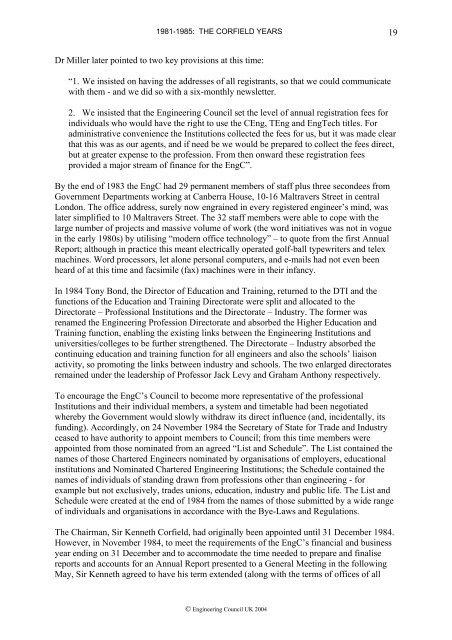An Engine for Change - A Chronicle of the Engineering Council
An Engine for Change - A Chronicle of the Engineering Council
An Engine for Change - A Chronicle of the Engineering Council
Create successful ePaper yourself
Turn your PDF publications into a flip-book with our unique Google optimized e-Paper software.
1981-1985: THE CORFIELD YEARS 19Dr Miller later pointed to two key provisions at this time:“1. We insisted on having <strong>the</strong> addresses <strong>of</strong> all registrants, so that we could communicatewith <strong>the</strong>m - and we did so with a six-monthly newsletter.2. We insisted that <strong>the</strong> <strong>Engine</strong>ering <strong>Council</strong> set <strong>the</strong> level <strong>of</strong> annual registration fees <strong>for</strong>individuals who would have <strong>the</strong> right to use <strong>the</strong> CEng, TEng and EngTech titles. Foradministrative convenience <strong>the</strong> Institutions collected <strong>the</strong> fees <strong>for</strong> us, but it was made clearthat this was as our agents, and if need be we would be prepared to collect <strong>the</strong> fees direct,but at greater expense to <strong>the</strong> pr<strong>of</strong>ession. From <strong>the</strong>n onward <strong>the</strong>se registration feesprovided a major stream <strong>of</strong> finance <strong>for</strong> <strong>the</strong> EngC”.By <strong>the</strong> end <strong>of</strong> 1983 <strong>the</strong> EngC had 29 permanent members <strong>of</strong> staff plus three secondees fromGovernment Departments working at Canberra House, 10-16 Maltravers Street in centralLondon. The <strong>of</strong>fice address, surely now engrained in every registered engineer’s mind, waslater simplified to 10 Maltravers Street. The 32 staff members were able to cope with <strong>the</strong>large number <strong>of</strong> projects and massive volume <strong>of</strong> work (<strong>the</strong> word initiatives was not in voguein <strong>the</strong> early 1980s) by utilising “modern <strong>of</strong>fice technology” – to quote from <strong>the</strong> first <strong>An</strong>nualReport; although in practice this meant electrically operated golf-ball typewriters and telexmachines. Word processors, let alone personal computers, and e-mails had not even beenheard <strong>of</strong> at this time and facsimile (fax) machines were in <strong>the</strong>ir infancy.In 1984 Tony Bond, <strong>the</strong> Director <strong>of</strong> Education and Training, returned to <strong>the</strong> DTI and <strong>the</strong>functions <strong>of</strong> <strong>the</strong> Education and Training Directorate were split and allocated to <strong>the</strong>Directorate – Pr<strong>of</strong>essional Institutions and <strong>the</strong> Directorate – Industry. The <strong>for</strong>mer wasrenamed <strong>the</strong> <strong>Engine</strong>ering Pr<strong>of</strong>ession Directorate and absorbed <strong>the</strong> Higher Education andTraining function, enabling <strong>the</strong> existing links between <strong>the</strong> <strong>Engine</strong>ering Institutions anduniversities/colleges to be fur<strong>the</strong>r streng<strong>the</strong>ned. The Directorate – Industry absorbed <strong>the</strong>continuing education and training function <strong>for</strong> all engineers and also <strong>the</strong> schools’ liaisonactivity, so promoting <strong>the</strong> links between industry and schools. The two enlarged directoratesremained under <strong>the</strong> leadership <strong>of</strong> Pr<strong>of</strong>essor Jack Levy and Graham <strong>An</strong>thony respectively.To encourage <strong>the</strong> EngC’s <strong>Council</strong> to become more representative <strong>of</strong> <strong>the</strong> pr<strong>of</strong>essionalInstitutions and <strong>the</strong>ir individual members, a system and timetable had been negotiatedwhereby <strong>the</strong> Government would slowly withdraw its direct influence (and, incidentally, itsfunding). Accordingly, on 24 November 1984 <strong>the</strong> Secretary <strong>of</strong> State <strong>for</strong> Trade and Industryceased to have authority to appoint members to <strong>Council</strong>; from this time members wereappointed from those nominated from an agreed “List and Schedule”. The List contained <strong>the</strong>names <strong>of</strong> those Chartered <strong>Engine</strong>ers nominated by organisations <strong>of</strong> employers, educationalinstitutions and Nominated Chartered <strong>Engine</strong>ering Institutions; <strong>the</strong> Schedule contained <strong>the</strong>names <strong>of</strong> individuals <strong>of</strong> standing drawn from pr<strong>of</strong>essions o<strong>the</strong>r than engineering - <strong>for</strong>example but not exclusively, trades unions, education, industry and public life. The List andSchedule were created at <strong>the</strong> end <strong>of</strong> 1984 from <strong>the</strong> names <strong>of</strong> those submitted by a wide range<strong>of</strong> individuals and organisations in accordance with <strong>the</strong> Bye-Laws and Regulations.The Chairman, Sir Kenneth Corfield, had originally been appointed until 31 December 1984.However, in November 1984, to meet <strong>the</strong> requirements <strong>of</strong> <strong>the</strong> EngC’s financial and businessyear ending on 31 December and to accommodate <strong>the</strong> time needed to prepare and finalisereports and accounts <strong>for</strong> an <strong>An</strong>nual Report presented to a General Meeting in <strong>the</strong> followingMay, Sir Kenneth agreed to have his term extended (along with <strong>the</strong> terms <strong>of</strong> <strong>of</strong>fices <strong>of</strong> all© <strong>Engine</strong>ering <strong>Council</strong> UK 2004
















